Physical Address
304 North Cardinal St.
Dorchester Center, MA 02124
The external ear lies lateral to the tympanic membrane. The pinna ( Fig. 27.1 ) is made of fibroelastic cartilage, the external auditory meatus has an outer cartilage portion and the inner part is formed by the tympanic bone ( Fig. 27.2 ). It is lined by squamous epithelium and contains ceruminous glands that produce wax. There is very little subcutaneous tissue, making soft tissue swelling very painful.
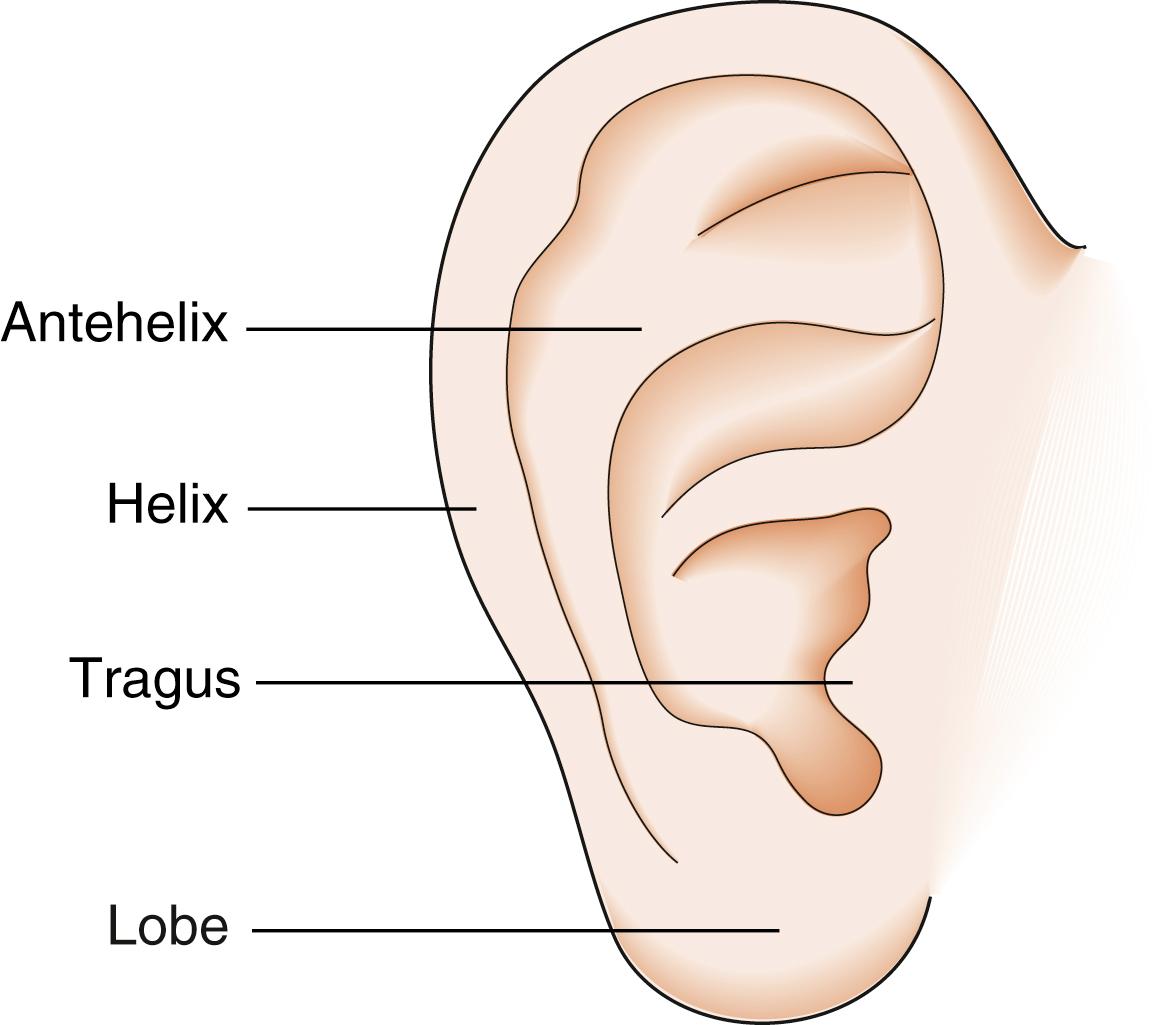
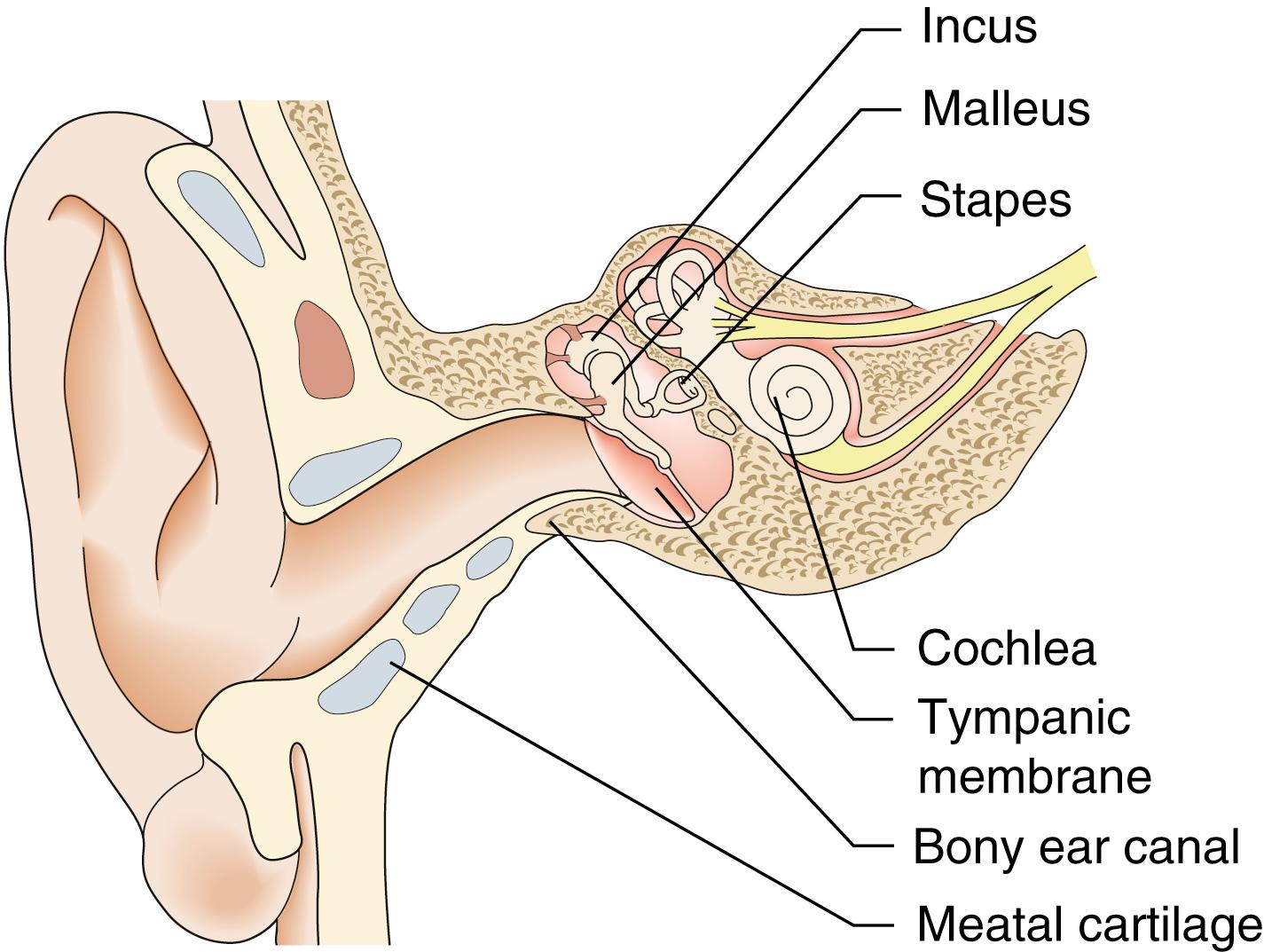
The middle ear is a complex space within the temporal bone with complex defined boundaries. The lateral vibrating tympanic membrane is conical, peripherally attached to the margin of the bony ear canal and centrally to the handle of the malleus, the most lateral of the three ossicles ( Fig. 27.2 ). The head of the malleus is attached to the body of the incus in the space superior to the middle ear known as the attic. The long process of the incus attaches to the head of the stapes. The stapes is joined to the oval window margin by the annular ligament on the medial wall of the middle ear, which is lined by simple cuboidal epithelium containing some mucus-secreting cells. The middle-ear space is connected to the nasopharynx by the Eustachian tube, which maintains the middle ear at atmospheric pressure.
The inner ear lies medial to the middle ear. It consists of a bony labyrinth, filled with perilymph fluid, which in turn encloses a membrane filled by a fluid called endolymph. The cochlea, the hearing component of the inner ear, is a tube linking the oval and round windows, and is coiled like a shell. The vestibular (balance) portion of the inner ear consists of three semicircular canals, together with their vestibule, which contains the saccule and utricle, medial to the stapes footplate. The cochlear and vestibular nerves combine in the internal auditory meatus and pass medially to the brainstem. Passing in the opposite direction, the facial nerve enters the temporal bone through the internal auditory meatus and traverses the temporal bone, emerging in relation to the parotid gland. During its intratemporal course, it passes laterally to the geniculate ganglion, where it turns posteriorly (the first genu). It passes through the middle ear above the oval window and turns inferiorly (the second genu) to exit at the stylomastoid foramen.
The pinna funnels sound into the ear canal. The tympanic membrane lever mechanism, the ossicular lever mechanism and the large size of the drum relative to the stapes footplate act as an impedance-matching transformer. Vibrations in air are thus transferred to the cochlear fluids without excessive loss of energy. The cochlea converts these endolymph vibrations into electrical impulses in the auditory nerve by movement of hair cells in the organ of Corti, which drives ion channels resulting in action potentials. The maximum response to high frequencies occurs in the basal turn of the cochlea, and low frequencies maximally stimulate the apex in a ‘tonotophic’ arrangement. Auditory neurons connect via the brainstem to the auditory cortex, where different groups of cells are again stimulated by nerve impulses coded for different frequencies. The hair cells in the ampullae of the semicircular canals are stimulated by angular acceleration, whereas the saccule and utricle are stimulated by linear acceleration. Information from the labyrinths, eyes and limbs is processed in the brainstem and contributes to the sense of balance. Connections from the vestibular nuclei pass to the cortex and cerebellum.
Disorders of the external or middle ear can impair sound transmission to the inner ear and cause conductive deafness. Sensorineural deafness results from lesions of the cochlea or its nerve. Deafness is often associated with a noise in the ear (tinnitus). Ear pain (otalgia) may be due to ear disease but may also be referred from other sites ( Table 27.1 ). Ear-related disorders of balance usually cause a sensation of movement (vertigo), most often rotation. ‘Unsteadiness’ without vertigo, however, typically has a nonotologic cause. Patients with ear disease occasionally fall to the ground due to imbalance but never lose consciousness secondary to an otologic cause.
| Pharynx and larynx |
|
| Mouth |
|
| Temporomandibular joints |
|
| Neck |
|
| Paranasal sinuses |
|
The ear canal and tympanic membrane are inspected with an otoscope, a rigid telescope or a microscope. Microscopy or endoscopy frees a hand that can then assist in wax or discharge removal. Tuning fork tests differentiate between conductive and sensorineural hearing loss (Rinne test). In health or sensorineural deafness, a tuning fork is heard better via the ear canal (air conduction) than via the mastoid process (bone conduction). In conductive hearing loss, the tuning fork is heard better by bone conduction. When hearing is symmetrical, a tuning fork placed in the centre of the forehead is heard equally well in both ears (Weber test). If a conductive hearing loss is present in one ear, the tuning fork is heard better in the deaf ear (confirmed by occluding one ear and applying the fork to your own head). Conversely, in unilateral sensorineural deafness, the sound is louder in the good ear. Free-field speech testing involves asking the patient to repeat a series of numbers spoken behind them during rubbing of the contralateral tragal cartilage to mask hearing on that side. The ‘normal’ hearing ear should reliably detect a whispered voice at arm’s length.
Hearing by air conduction can be assessed by pure tone audiometry in which sounds of known pitch and loudness are presented to each ear in turn via headphones. Bone conduction (cochlear function) can be separately tested by applying sounds to the mastoid process. A contralateral masking tone is needed if each cochlea is to be tested separately. The difference between the air and bone conduction gives the level of conductive hearing loss ( Figs. 27.3 and 27.4 ). The patient’s ability to hear speech can be tested by presenting lists of words via headphones. Middle-ear pressure (compliance) can be assessed by tympanometry. The amount of sound from a probe reflected from the drum is measured while the pressure in the ear canal is varied. The compliance is maximal when the pressure in the ear canal equals the pressure in the middle ear, because the drum is maximally mobile at this point. Tympanometry is most often used to confirm the presence of fluid in the middle ear.
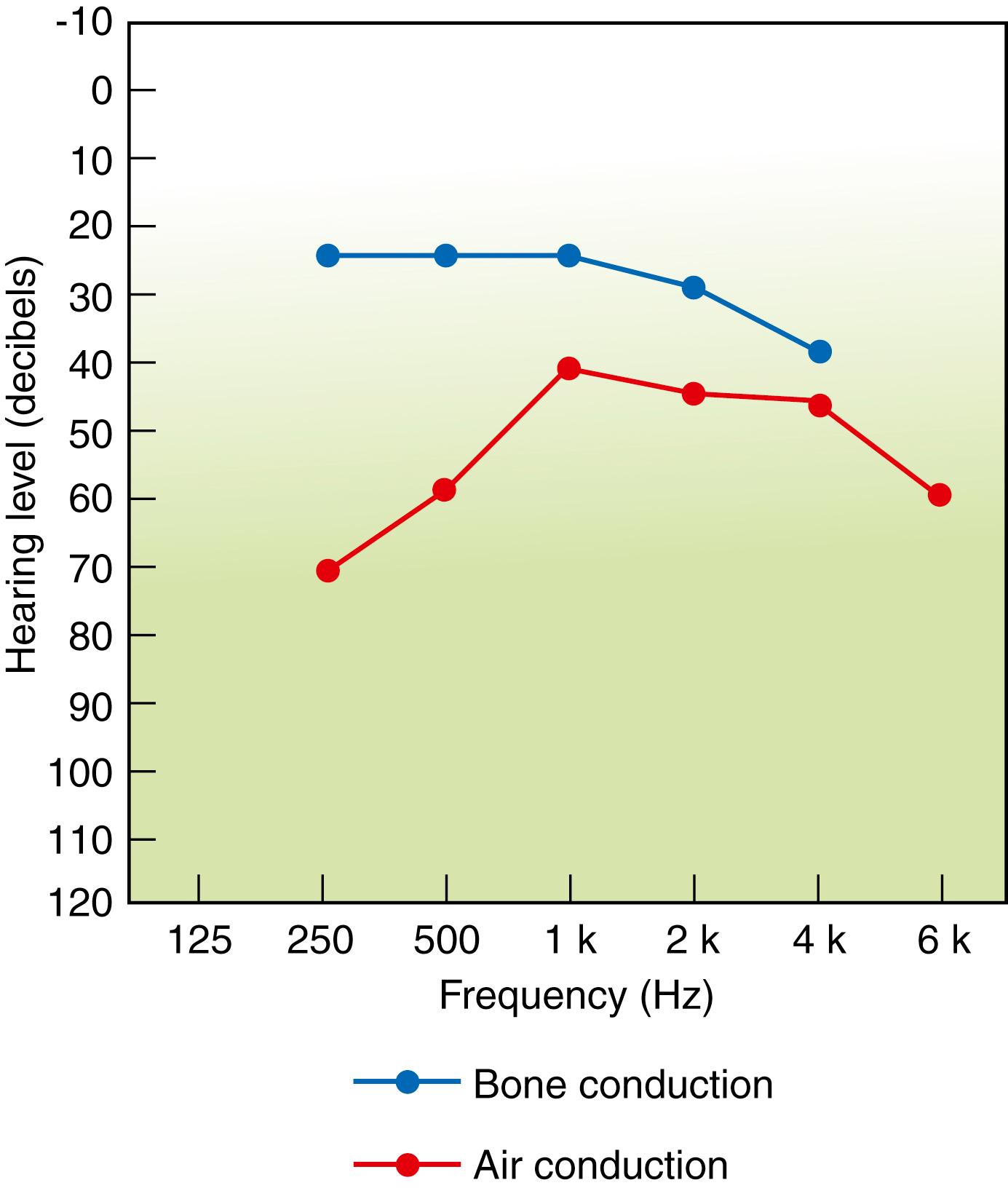
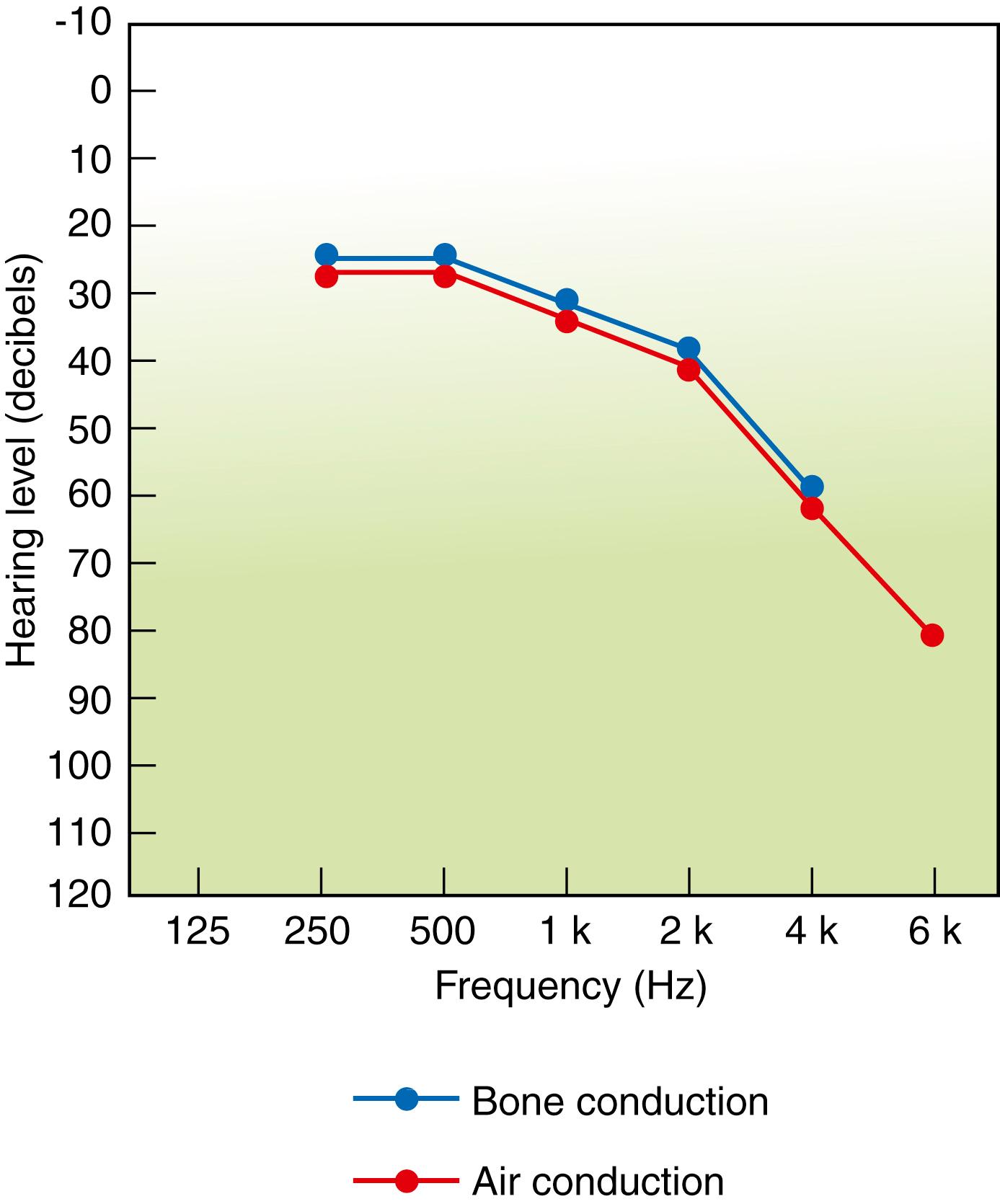
In patients with unilateral sensorineural hearing loss, magnetic resonance imaging (MRI) is used to detect lesions involving the vestibulocochlear nerve (most commonly acoustic neuromas) ( Fig. 27.5 ). MRI also demonstrates the presence of normal fluid in the cochlea before attempting cochlear implantation. Computed tomography (CT) can be used to demonstrate temporal bone anatomy, congenital abnormalities, fractures or unusual pathology.
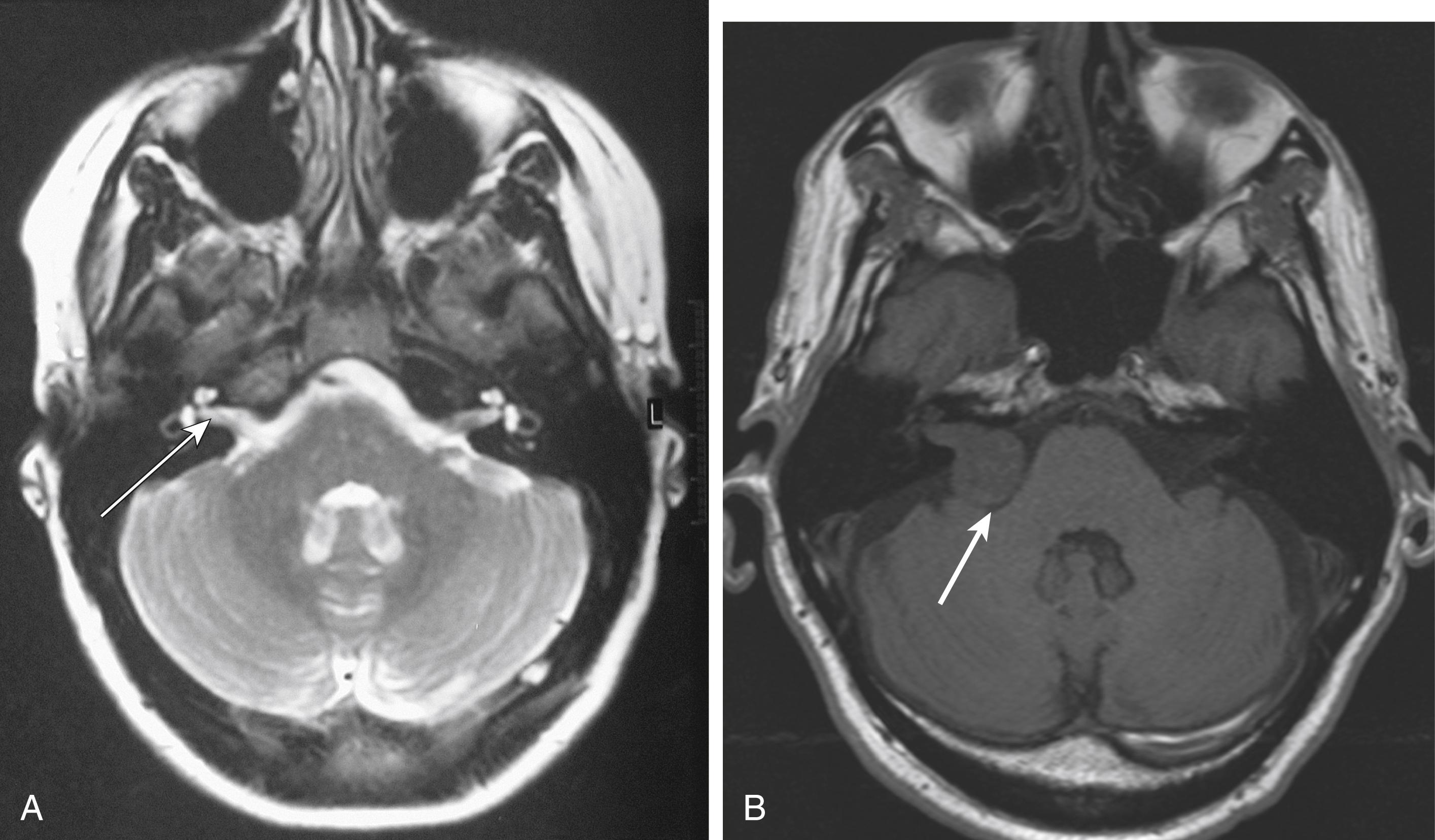
Bat ears are a developmental abnormality resulting in absence of the antihelical fold (see Fig. 27.1 ). This produces prominent ears that can result in embarrassment, but the abnormality can be corrected surgically.
Trauma to the ear may result in a haematoma, which strips the perichondrium off the underlying cartilage. Secondary infection may lead to loss of cartilage, resulting in a ‘cauliflower ear’. Haematomas should therefore be drained under strict aseptic conditions.
Basal cell and squamous carcinomas may occur on the pinna and require excision ( Fig. 27.6 ).
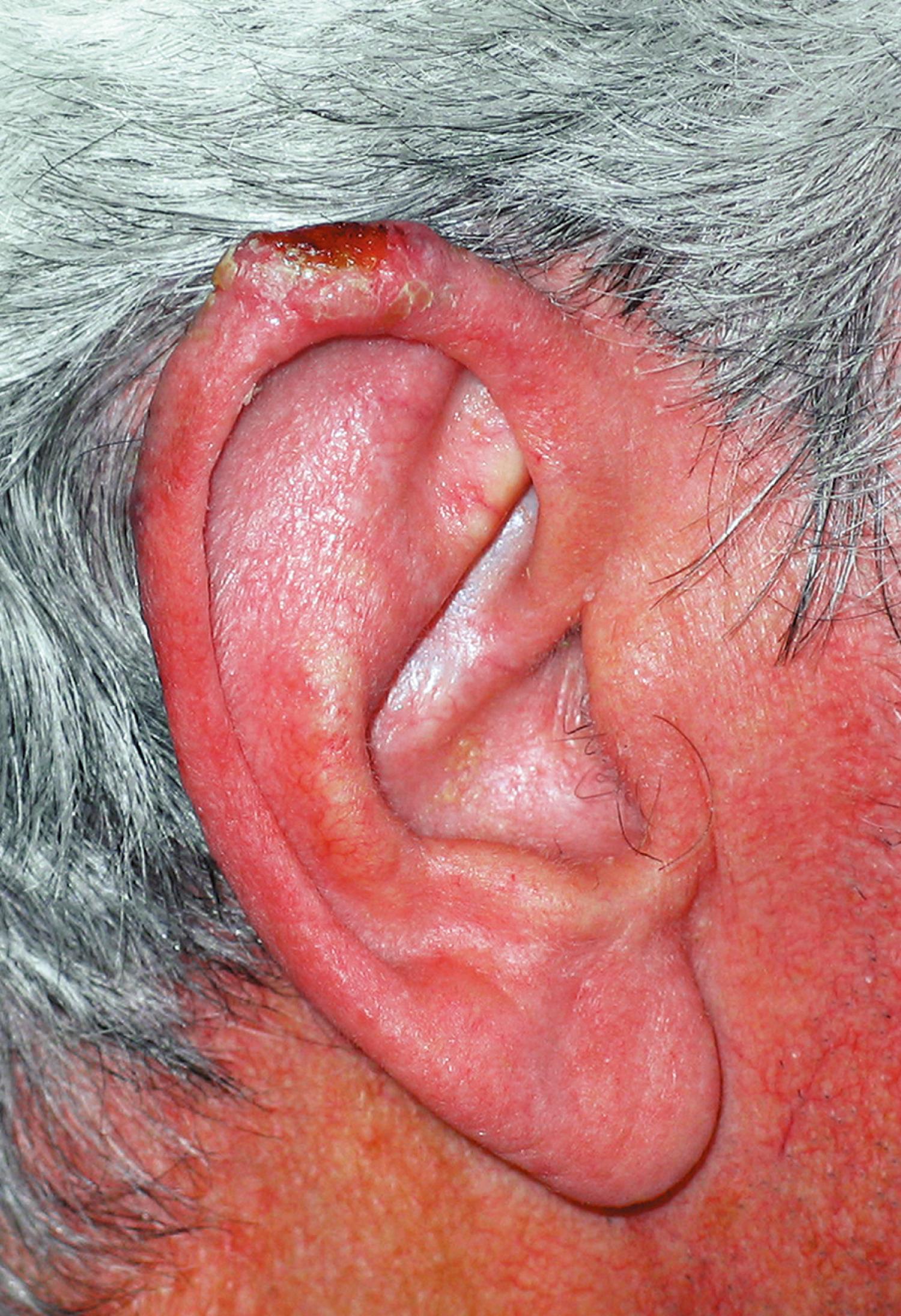
Wax (cerumen) is normally found in the ear canal. The ear canal has a migratory epithelium that carries wax to the opening of the external auditory meatus. Wax seldom causes deafness unless it becomes packed against the eardrum. Sodium bicarbonate ear drops should be used regularly by those with a tendency to build up excess cerumen to naturally improve wax clearance.
This is a very common inflammatory condition of the ear canal skin. Secondary infection with bacteria or, less frequently, fungi may occur. In the chronic state, this can be managed with steroid preparations, much like eczema, although drops are required to access the ear canal rather than cream. If a secondary infection develops, topical antibiotic drops or spray may be used, although if a significant amount of debris develops, microsuction may be required to clear the ear canal. Petroleum jelly-coated plugs eradicate entry of water and irritant detergent (shampoo) or swimming pool water, which can be helpful for preventing problems. The head and hair should not be cleaned under a shower spray but in a basin. Excessive hairwashing should be avoided, as well as cotton bud use.
Malignant otitis external is an aggressive variant usually seen in older people, particularly those with diabetes mellitus. It can result in skull base erosion and death if not adequately treated by prolonged intravenous antibiotic therapy.
Squamous carcinoma of the ear canal occurs uncommonly and is treated by a combination of surgery and radiotherapy.
This common bacterial infection of the middle ear space is usually caused by Streptococcus pneumoniae or Haemophilus influenzae, most commonly occurring in young children (3 years of age and under). Children present with a combination of ear pain (otalgia), fever and malaise. On examination, dilated blood vessels are seen on the drum surface in the early stages. The drum then becomes red and bulges. Perforation with discharge and sudden symptom resolution frequently occurs, usually followed by spontaneous healing of the drum. Antibiotic therapy remains controversial: the majority of cases resolve spontaneously in a few days, but antibiotics may play a part in those under 2 years of age with more severe signs ( EBM 27.1 ). Antibiotics are also useful in high-risk patients (e.g., immunosuppression) as they shorten the episodes and reduce the rate of infective complications such as mastoiditis, facial palsy or meningitis.
In this condition, fluid accumulates in the middle-ear space, usually in children. A minority of adult cases are caused by nasopharyngeal tumours and systemic disease. Childhood otitis media with effusion (OME) causes hearing loss and may interfere with the acquisition of language and performance at school. Virtually all cases resolve spontaneously, but this may take as long as 10 years. Initial management involves documentation of the presence of effusion and degree of hearing loss during a period of watchful waiting. If effusions persist, hearing may be improved by drainage of the effusion (myringotomy) and insertion of a ventilation tube ( Fig. 27.7 ) or alternatively by using a hearing aid until the effusion settles. In children, removal of the adenoids may add benefit ( EBM 27.2 ). Spontaneous resolution may also occur in adults, but effusions often persist. Ventilation tubes can be of value in adults.
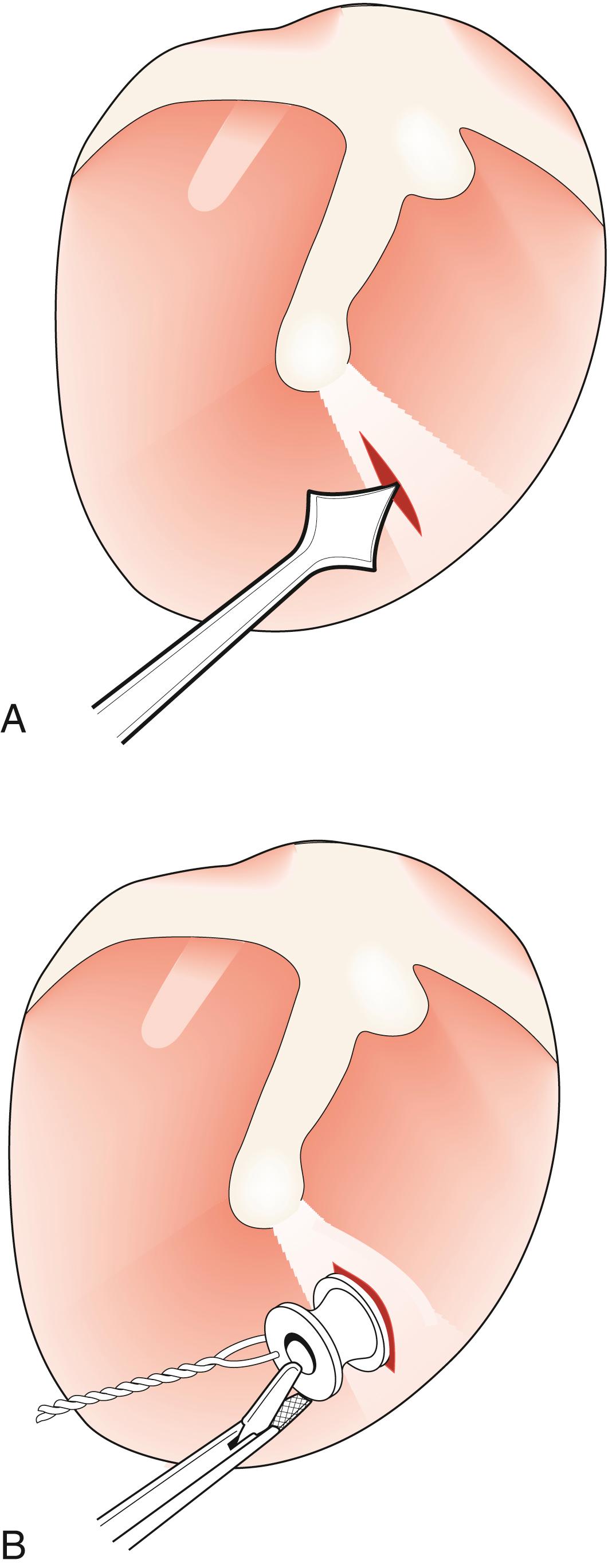
This causes aural discharge and deafness, and is characterised by the presence of a perforation of the tympanic membrane, which typically discharges. Swimming and other activities that involve water entering the ear may exacerbate the discharge. Hearing loss progresses as the ossicles are eroded, most commonly the incus long process. Discharge can be controlled by cleaning the ear and using antibiotic eardrops. A decision regarding suitability for surgery is individualised but aims to close the perforation and provide a dry ear, which is achieved in over 80% of cases. The operation to repair a perforation is called a myringoplasty , but surgical restoration of hearing is less reliable. Defects of the ossicular chain can be repaired by removing the incus and repositioning it to bridge the gap between the malleus and stapes, or by using a prosthesis (ossiculoplasty).
A cholesteatoma forms as a retracted area of the drum (most commonly in the attic region) in which keratin accumulates due to migratory epithelium discussed previously.
In acute otitis media (AOM), antibiotics are most useful in children < 2 years old with bilateral AOM, or with both AOM and otorrhoea. Most other children with mild disease in high-income countries can be offered an expectant observational approach.
In otitis media with effusion (OME), adenoid removal may decrease the risk of repeated surgery in children older than 4 years.
The tissue at the periphery of the cholesteatoma produces several chemical mediators that stimulate osteoclast activity. Hence, the cholesteatoma can erode surrounding bone and cause complications such as disruption of the ossicular chain, facial palsy, meningitis and brain abscess. Surgical treatment (mastoidectomy) is mandatory to eliminate the disease in all but the very elderly and those who are medically unfit.
Low-quality evidence from randomised controlled trials shows a benefit from the combination of antivirals with corticosteroids compared with corticosteroids alone for the treatment of Bell’s palsy of various degrees of severity.
Corticosteroids alone were more effective than antivirals alone.
There was no benefit from antivirals alone over placebo.
Moderate-quality evidence indicated that the combination of antivirals and corticosteroids reduced sequelae of Bell’s palsy compared with corticosteroids alone.
Acute otitis media is very common in patients under the age of 3 years.
The child typically awakes crying at night with a painful ear. A red, inflamed, bulging drum on otoscopy is diagnostic.
Pain relief is important.
Otitis media with effusion (glue ear) occurs transiently in many children. Most resolve spontaneously. Bilateral persistent hearing loss may respond to surgery (adenoidectomy or insertion of a grommet) or hearing aid provision if persistent.
Chronic mucosal otitis media involves the middle ear and mastoid. There is tympanic membrane perforation, hearing loss and a mucopurulent discharge. Recurrently active ears often require closure of the perforation (myringoplasty) and ossicular chain reconstruction.
Chronic squamous otitis media (cholesteatoma) may require surgical removal of the retracted drum and posterior ear canal wall to prevent accumulation of epithelium and subsequent complications.
This is a condition in which the stapes footplate becomes fixed by new bone formation. It is more common in females and sometimes runs in families. The hearing loss can be managed with a hearing aid or treated by stapedectomy, in which the stapes is replaced by a piston attached to the incus. This produces excellent hearing improvement in most patients, but a minority suffer from surgically induced, permanent inner ear damage.
Deafness is most commonly due to changes in the cochlea ( Table 27.2 ). Ageing produces a gradual bilateral deterioration in hearing acuity (presbycusis). Unilateral hearing loss occurs in acoustic neuroma (see Fig. 27.5B ). Most cases of inner-ear deafness are managed with a hearing aid, but in cases of profound bilateral deafness, hearing may be restored by a cochlear implant. This consists of a series of electrodes surgically introduced into the cochlea. An external speech processor converts sound into electrical energy, which directly stimulates the cochlear nerve.
|
In some cases, balance disorders may arise from abnormalities of the vestibular portion of the inner ear.
Benign paroxysmal positional vertigo (BPPV) is very common in middle age and is due to debris floating in the posterior semicircular canal, which stimulates the ampullary hair cells, producing vertigo. Episodes last for a few seconds and are triggered when the affected ear is down-most, as when the patient turns over in bed. Debris can be displaced therapeutically from the posterior canal by positioning the head so that it floats out of the canal into the vestibule (Epley particle repositioning manoeuvre). If this fails, division of the ampullary (singular) nerve or occlusion of the posterior semicircular canal can be beneficial.
Vestibular neuronitis causes severe vertigo that lasts days to weeks, but hearing remains normal. This is due to severe temporary reduction of vestibular function in the affected ear. Patients are managed by bed rest and vestibular sedatives, such as prochlorperazine.
Abnormal fluctuations of fluid pressure within the inner ear (endolymphatic hydrops) produce a combination of fluctuating deafness, tinnitus and vertigo known as Ménière disease. This uncommon condition is initially treated medically, using either a vasodilator agent (e.g., betahistine) or a diuretic. If medical treatment fails, the vestibular portion of the labyrinth may be destroyed by a middle-ear injection of gentamicin. Procedures of last resort are surgical destruction of the labyrinth or section of the vestibular nerve.
Upper motor neurone (central) causes of facial palsy, such as stroke, do not involve the forehead, which has bilateral central representation. Lower motor neurone facial palsy result from injury to the nerve anywhere through its course, most commonly due to temporal bone fractures or surgical trauma. A divided nerve may be repaired by end-to-end anastomosis or a cable graft derived from a sensory nerve of the right size, such as the sural nerve. Bell’s palsy, an idiopathic (lower motor neurone) facial palsy, usually improves spontaneously. There is some evidence that it is caused by viral infection, and steroid therapy given soon after the onset is beneficial. Herpes zoster infection of the geniculate ganglion causes facial palsy, often associated with deafness and vertigo (Ramsay–Hunt syndrome). Vesicles may be seen on the palate and the tympanic membrane. Antiviral treatment appears helpful for Ramsay–Hunt syndrome, but evidence is less convincing in Bell’s palsy ( EBM 27.2 ). Malignant tumours in the parotid area of the neck can also cause lower motor neurone facial palsy.
The nasal skeleton consists of two nasal bones superiorly and two pairs of cartilages inferiorly ( Fig. 27.8 ). The nasal cavity is divided in two by a partition composed of cartilage anteriorly and bone posteriorly (the nasal septum). Three turbinate bones protrude from the lateral wall of the nose ( Fig. 27.9 ). Between the inferior and middle turbinates is the middle meatus of the nose. Most of the paranasal sinuses open into this area under cover of a soft tissue flap known as the uncinate process. Obstruction of the sinus ostia can cause sinus pain and may lead to sinus infection. Above the superior turbinate is olfactory epithelium. The anterior portion of the nasal septum is called Little’s area. It carries prominent veins and is the site of most nose bleeds.
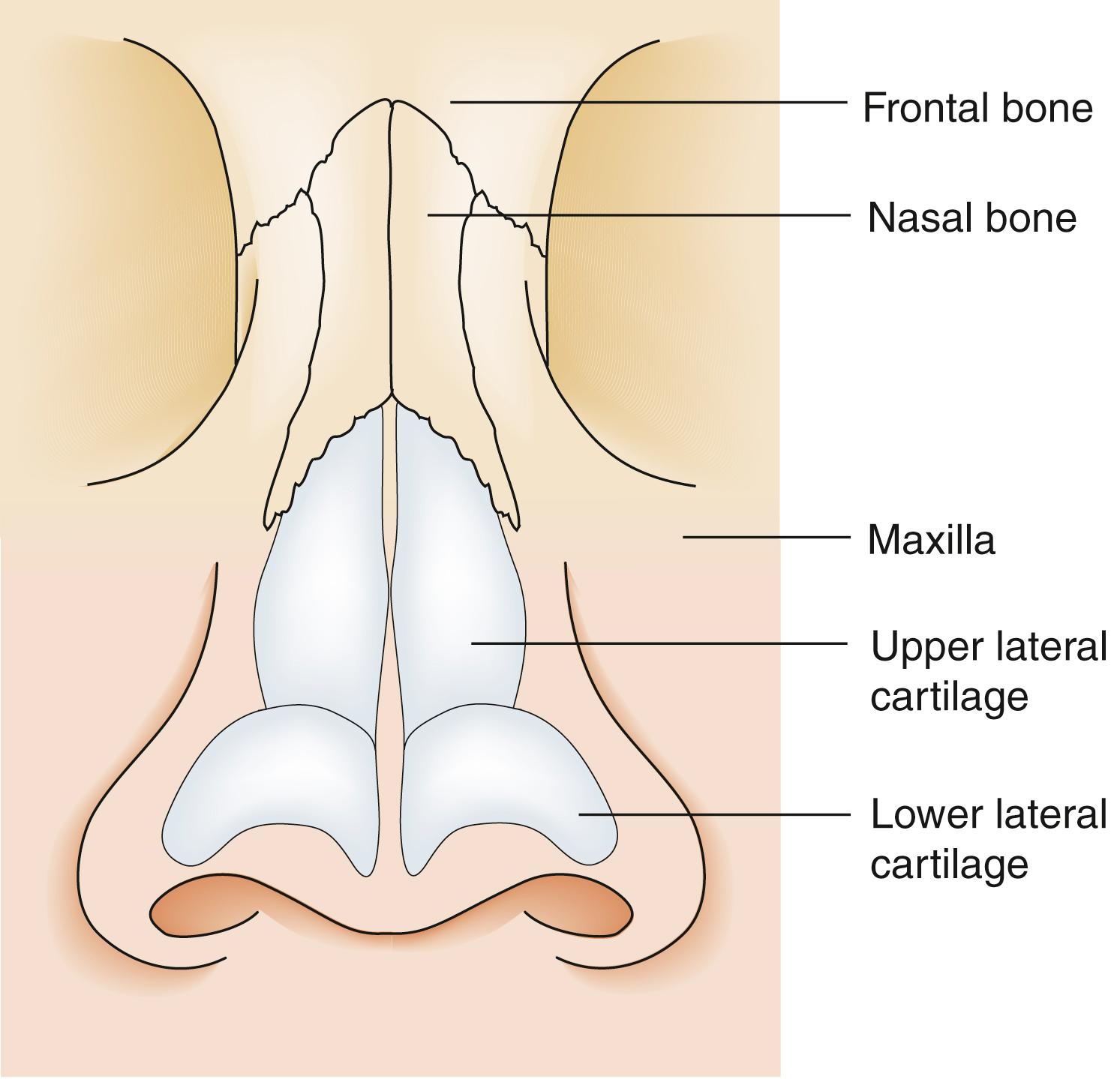
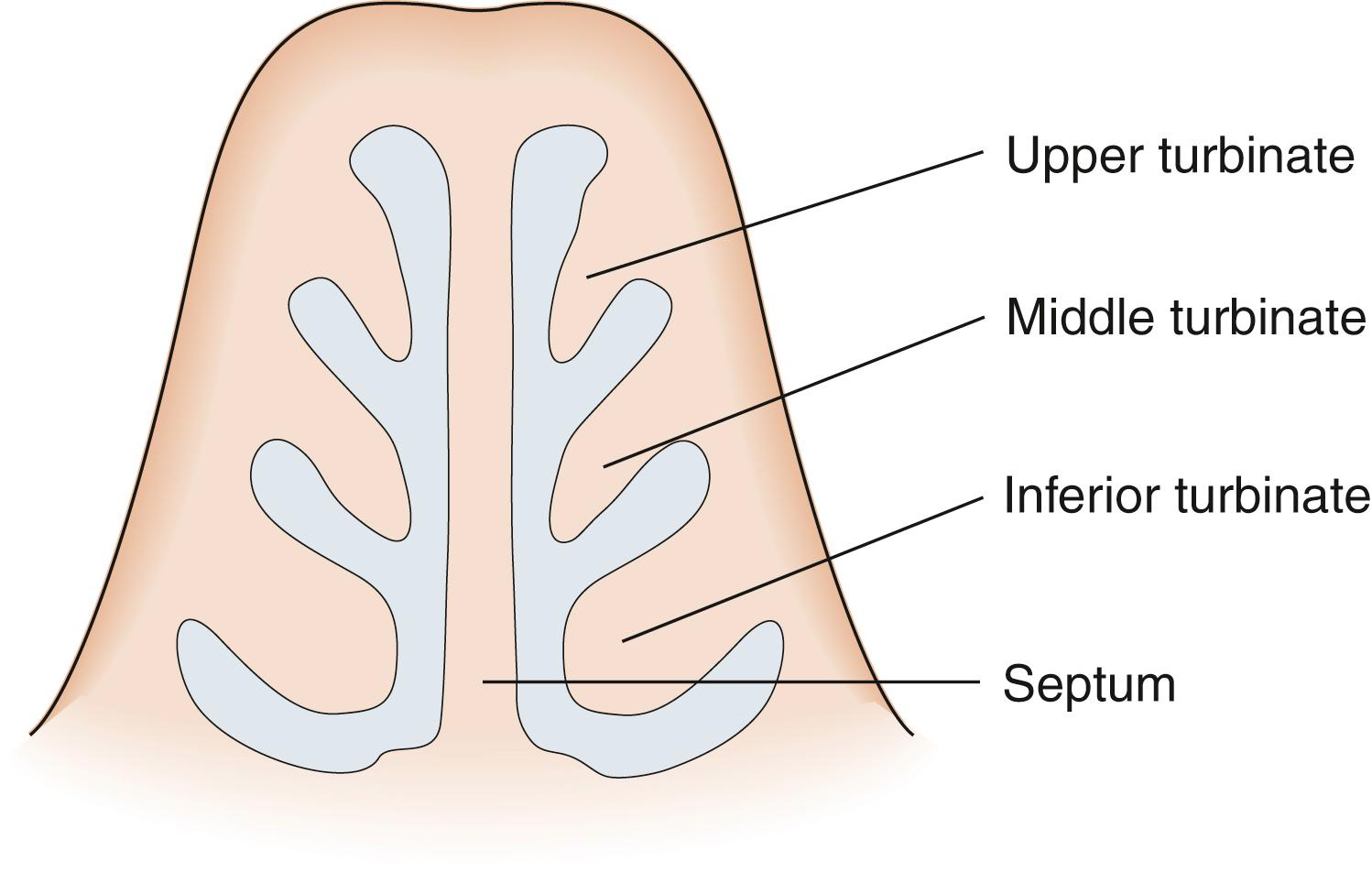
The functions of the nose are to filter, warm and moisten inspired air. Olfaction is important in its own right and as an adjunct to taste.
Nasal obstruction is a common symptom with several causes. Sneezing and rhinorrhoea are generally due to chronic rhinitis. Purulent nasal discharge and facial pain occur in sinusitis. Loss of smell may be conductive due to nasal blockage that prevents odours from reaching the olfactory epithelium or sensorineural secondary to damage of the olfactory nerves. Smell is an important part of taste, and reduced taste is therefore usually also reported by patients with anosmia.
The nasal cavity can be inspected using a nasal speculum or an otoscope. More detailed examination, particularly of the posterior part of the nose, is carried out with a rigid telescope.
Imaging is not required if nasendoscopy is normal. Images are useful preoperatively to guide the surgeon as to individual variations, especially in the areas of potential surgical hazard: orbital wall and floor of the anterior cranial fossa (skull base). CT is the best means of imaging the paranasal sinuses and the middle meatus of the nose, where the sinus ostia are situated ( Fig. 27.10 ). The sinuses can also be visualised by MRI, which allows differentiation of tumour from trapped secretions.
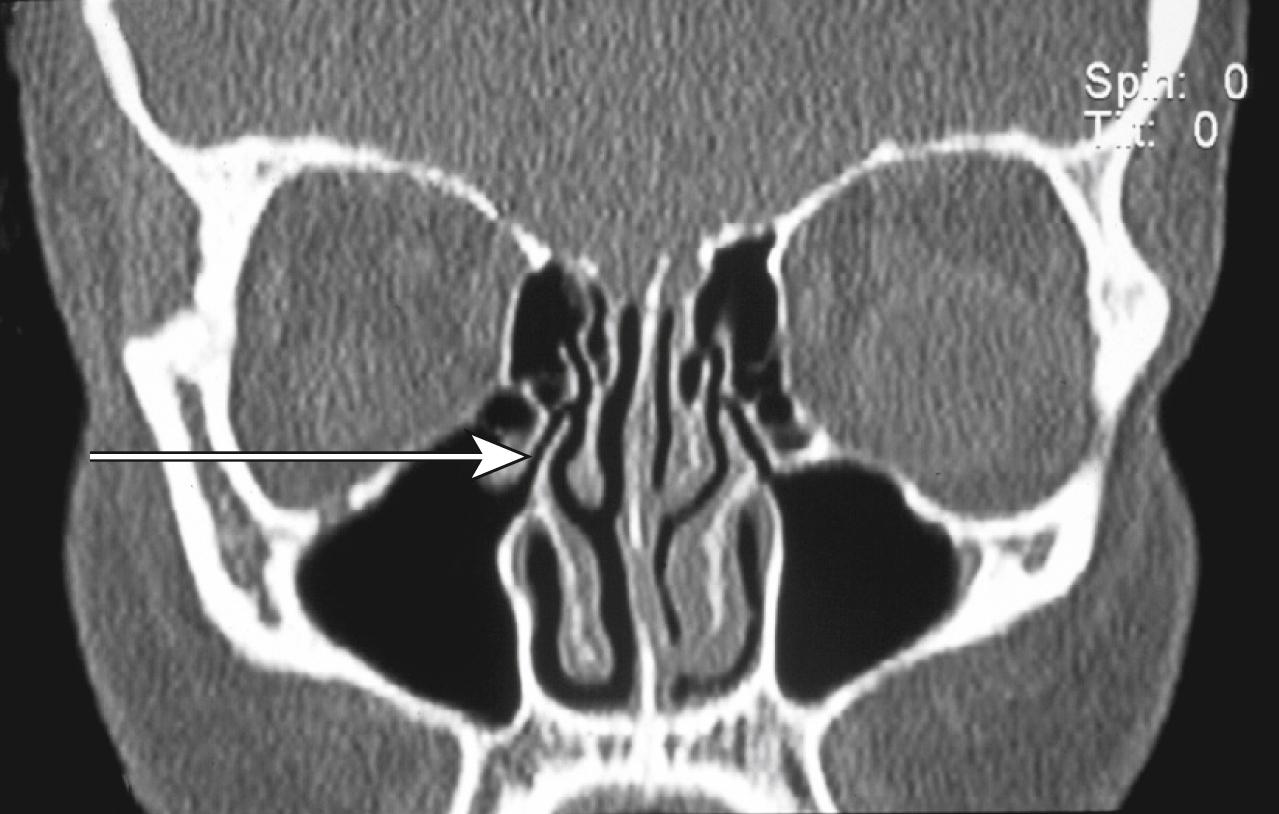
This may result in fracture and displacement of the nasal bones. If the fracture is not reduced within 14 days, it is usually fixed and hard to mobilise. There may also be displacement and fracture of the septal cartilage and bone (deviated nasal septum; Fig. 27.11 ). Corrective septoplasty surgery requires a posttrauma interval of 3 months to allow for soft tissue repair before surgery. Bleeding into the subperichondrial space of the septum causes a septal haematoma, resulting in severe nasal obstruction. This should be drained under aseptic conditions to prevent a septal abscess and collapse of the bridge.
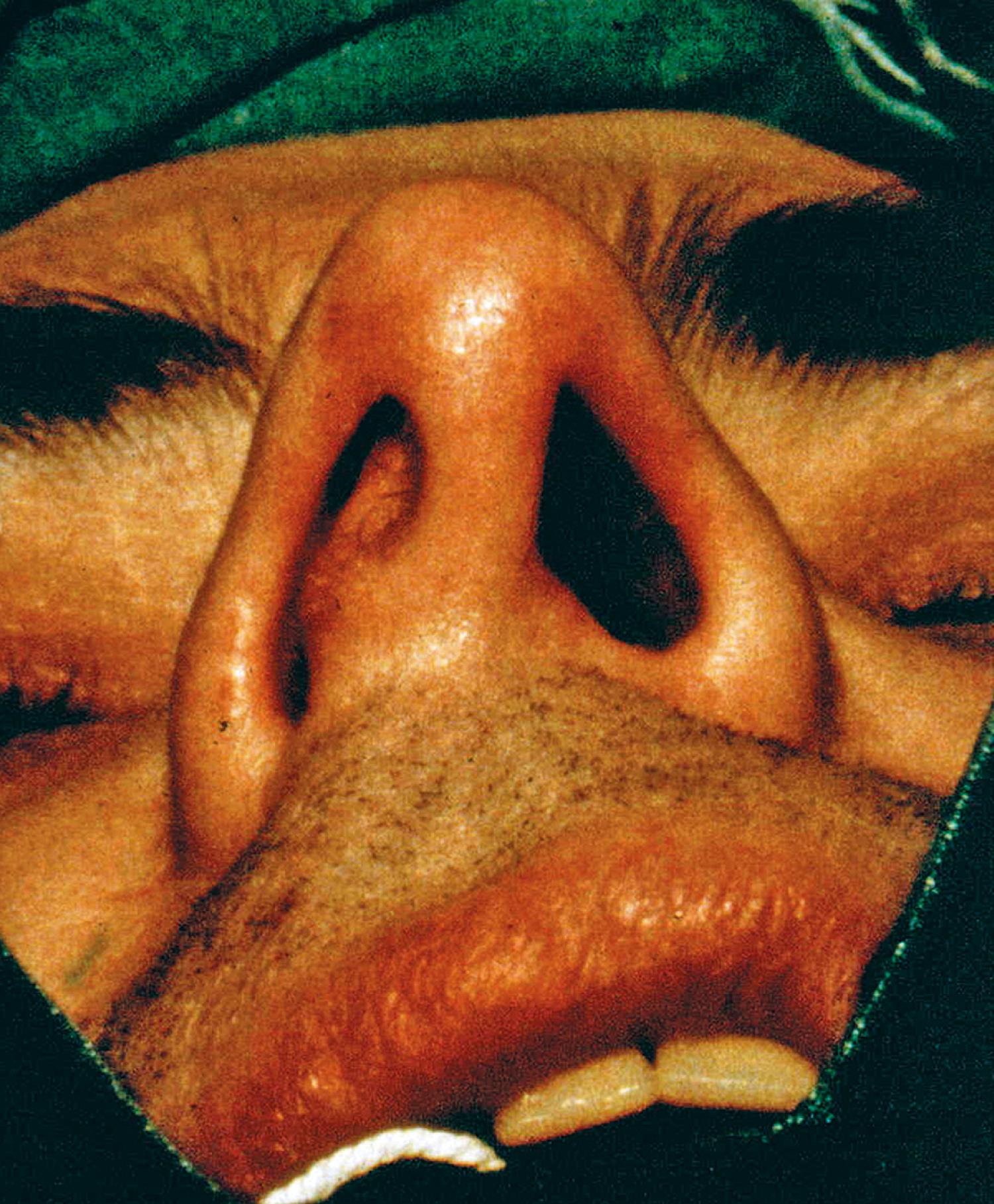
Some cases are due to allergy to aeroallergens (pollen or dust), otherwise it seems to be a reaction to environmental conditions such as temperature and humidity. It may be seasonal (usually summer) or perennial. Patients complain of nasal blockage that often switches from side to side, sneezing and rhinorrhoea. Most cases are best managed medically with a steroid nasal spray and saltwater rinsing. In severe cases with nasal obstruction, reduction of the inferior turbinates may provide relief.
Oedematous paranasal sinus mucosa extrudes through sinus ostia to produce nasal polyps. Most are multiple bilateral swellings from the ethmoid sinuses. Rarely, there is a single posterior protrusion from the maxillary sinus (antrochoanal polyp). Unilateral disease is unusual and should be approached with CT and biopsy to exclude a true tumour ( Fig. 27.12 ). Temporary improvement in the resulting nasal obstruction can be produced by topical or systemic steroids. As most polyps will recur following excision, most patients are managed with long-term steroids and only resort to surgery for uncontrollably severe symptoms. Endoscopic clearance is facilitated by use of a microdebrider.
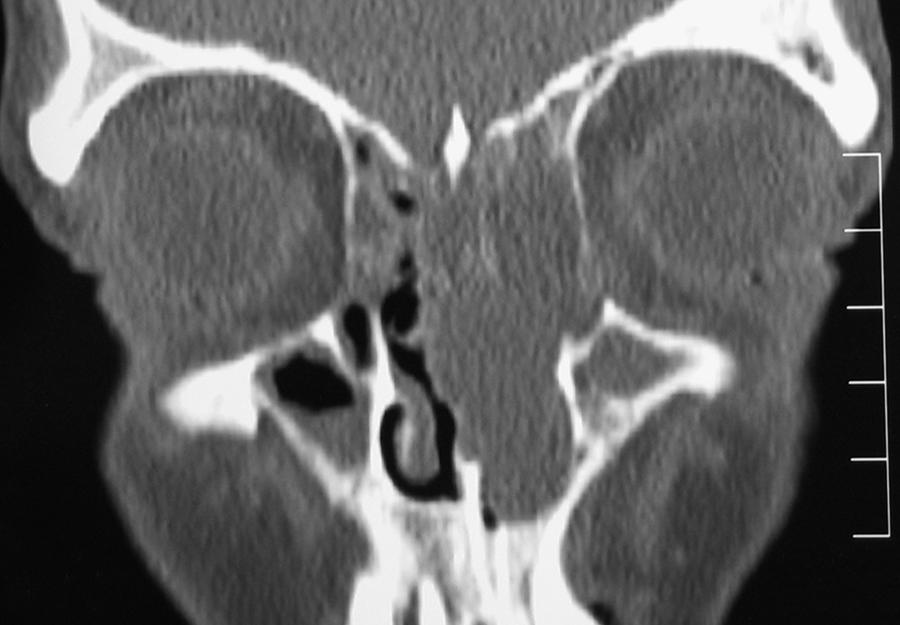
Nose bleeds may be associated with several disease processes ( Table 27.3 ). They are common in healthy children and young adults. Bleeding usually arises from Little’s area and can be controlled by squeezing the front of the nose ( Fig. 27.13 ). In the elderly, more severe bleeding from further back in the nose may occur, and in these cases, attempts should be made to find the bleeding point. If this cannot be achieved, a nasal pack may be required to arrest the bleeding. Bleeding may be associated with the use of nonsteroidal antiinflammatory drugs (NSAIDs) or other antithrombotic therapies in this group. Severe bleeding not controlled by a pack can be arrested by clipping either the sphenopalatine, anterior ethmoid or maxillary artery.
| Bleeding disorders |
|
| Systemic disease |
|

Epistaxis in young patients usually arises from a small blood vessel in Little’s area; in older individuals, it arises from an arteriosclerotic vessel located more posteriorly.
Pressure on Little’s area by compressing the anterior septum usually stops the bleeding. Topical 1:1000 adrenaline (epinephrine) on cotton wool may help.
Bleeding more posteriorly may require balloon compression or packing.
Consider coagulation defects including alcohol and nonsteroidal analgesics.
Persistent epistaxis may require embolisation or ligation of the sphenopalatine branch(es) of the maxillary artery.
The paranasal sinuses are air-filled cavities that open into the nasal cavity, mostly into the middle meatus of the nose. The maxillary sinuses occupy the cheeks ( Fig. 27.14 ), whereas the ethmoid labyrinth consists of several air cells lying between the orbits. The frontal sinus is an ethmoid air cell that has migrated into the frontal bone, and it is connected to the middle meatus of the nose via the frontonasal duct. The sphenoid sinus is posterior to the ethmoid labyrinth and inferior to the pituitary fossa.
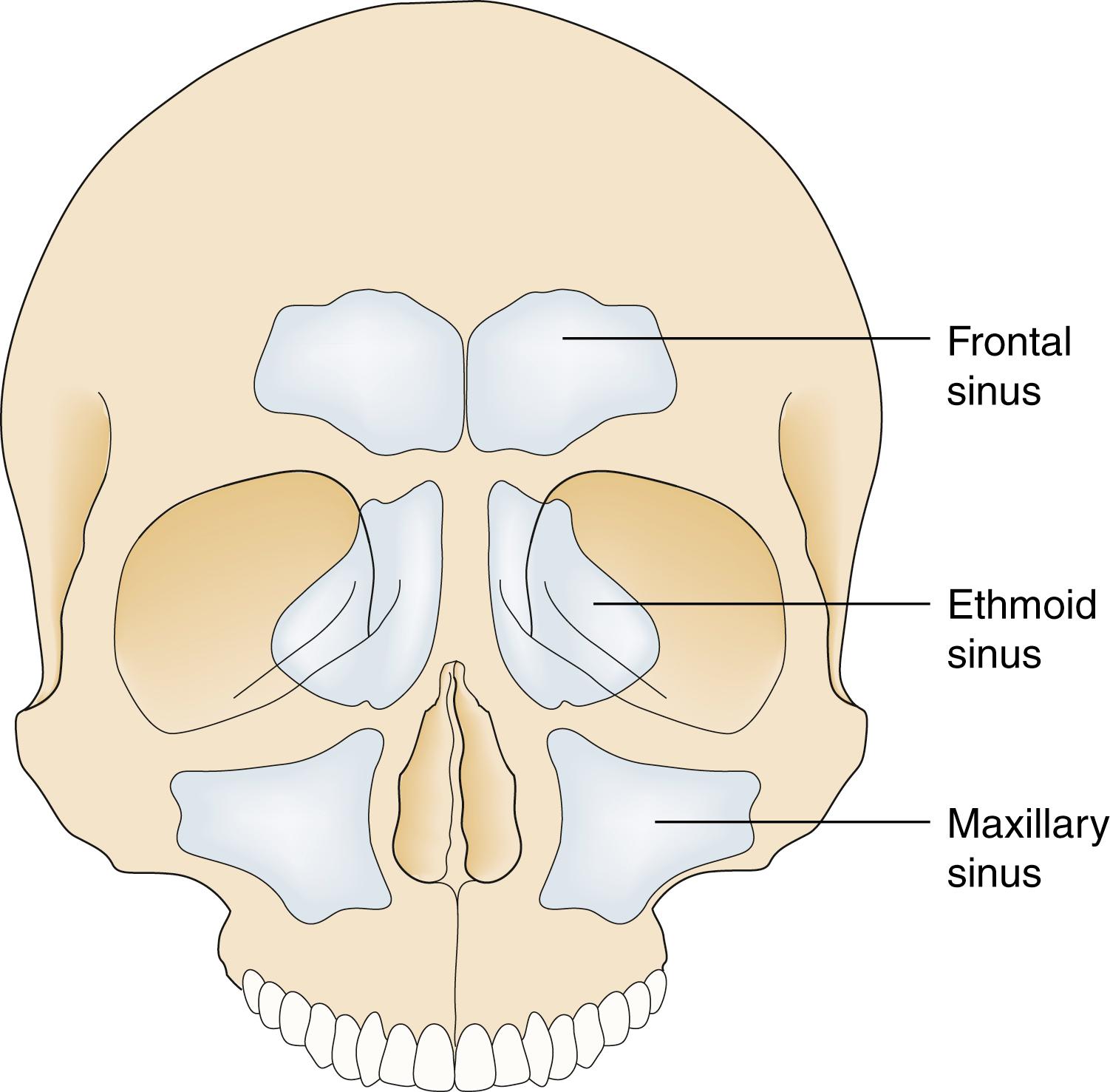
Become a Clinical Tree membership for Full access and enjoy Unlimited articles
If you are a member. Log in here